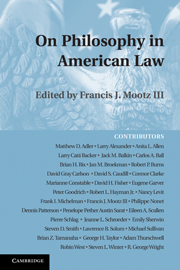Book contents
- Frontmatter
- Contents
- Introduction
- PART I KARL LLEWELLYN AND THE COURSE OF PHILOSOPHY IN AMERICAN LAW
- PART II PHILOSOPHICAL PERSPECTIVES ON LAW
- PART III AREAS OF PHILOSOPHY AND THEIR RELATIONSHIP TO LAW
- PART IV PHILOSOPHICAL EXAMINATIONS OF LEGAL ISSUES
- 18 Law as Premise
- 19 Doing Justice to Justice: Paul Ricoeur
- 20 Love Is All You Need: Freedom of Thought versus Freedom of Action
- 21 Legal Philosophy over the Next Century (While We Wait for the Personal Rocket Transportation We Were Promised)
- 22 Atmospherics: Abortion Law and Philosophy
- PART V LAW, RHETORIC, AND PRACTICE THEORY
- PART VI QUESTIONING THE RELATIONSHIP BETWEEN PHILOSOPHY AND AMERICAN LAW
- PART VII COMMENTARIES
- Contributors and Selected Bibliography
- Name Index
21 - Legal Philosophy over the Next Century (While We Wait for the Personal Rocket Transportation We Were Promised)
Published online by Cambridge University Press: 31 July 2009
- Frontmatter
- Contents
- Introduction
- PART I KARL LLEWELLYN AND THE COURSE OF PHILOSOPHY IN AMERICAN LAW
- PART II PHILOSOPHICAL PERSPECTIVES ON LAW
- PART III AREAS OF PHILOSOPHY AND THEIR RELATIONSHIP TO LAW
- PART IV PHILOSOPHICAL EXAMINATIONS OF LEGAL ISSUES
- 18 Law as Premise
- 19 Doing Justice to Justice: Paul Ricoeur
- 20 Love Is All You Need: Freedom of Thought versus Freedom of Action
- 21 Legal Philosophy over the Next Century (While We Wait for the Personal Rocket Transportation We Were Promised)
- 22 Atmospherics: Abortion Law and Philosophy
- PART V LAW, RHETORIC, AND PRACTICE THEORY
- PART VI QUESTIONING THE RELATIONSHIP BETWEEN PHILOSOPHY AND AMERICAN LAW
- PART VII COMMENTARIES
- Contributors and Selected Bibliography
- Name Index
Summary
Prediction poses special difficulties, as those of us who were once confidently promised personalized rocket transportation can attest. Some predictions can be left vague, and thus conveniently reinterpretable or indefinitely deferrable. But real predictions are falsifiable, sometimes even within the compass of the predictor's own professional career. Appreciating this awkward possibility, we often succumb to the temptation to limit our predictions to mere extrapolation. Predicting only incremental change along preexisting lines may be less interesting than predicting sharp discontinuities, path dependencies, random walks, catastrophes, chaotic swirls, tipping points, symmetry breaks, cascades, emergent properties, butterfly effects, or exponential acceleration. The payoff for mere extrapolationism is in seeming levelheaded and judicious.
One crucial problem with the strategy of extrapolationism, though, is that current trends often go south surprisingly quickly. And over the truly long haul, even betting on a normally sure thing, such as increasing entropy, will at some point have no future. Most established trends in legal philosophy, it is fair to guess, will unravel long before entropy halts its advance.
Legal philosophers recognize all of this. Asked to depict likely scenarios for legal philosophy over the century hence, most would resist the temptation to limn merely a contest among, say, recognizable descendents of today's inclusive legal positivists, exclusive legal positivists, and a smattering of broadly described natural law theorists. Even if that were indeed the single most likely scenario among many alternatives, it seems too unlikely to place many chips on.
- Type
- Chapter
- Information
- On Philosophy in American Law , pp. 176 - 183Publisher: Cambridge University PressPrint publication year: 2009

